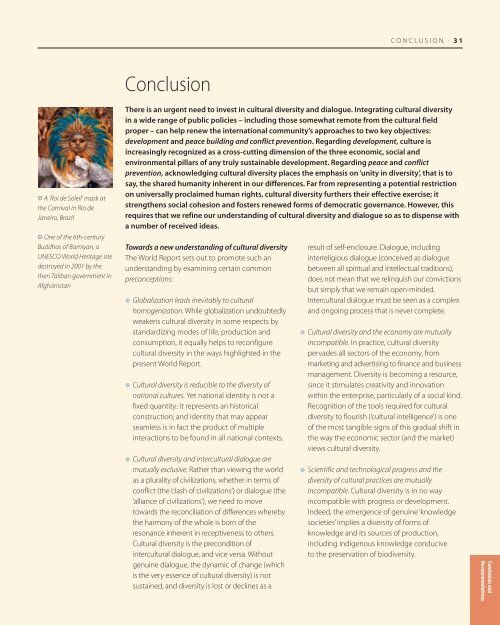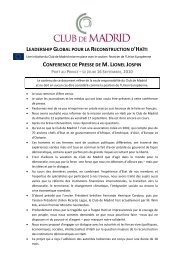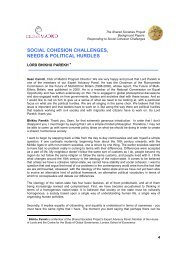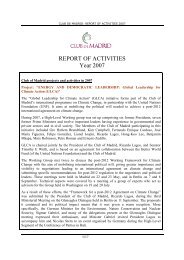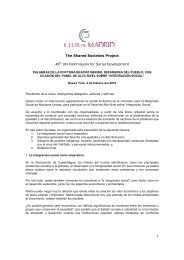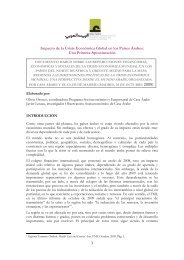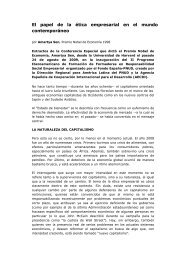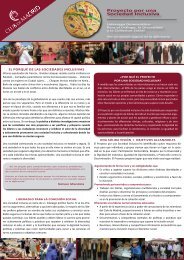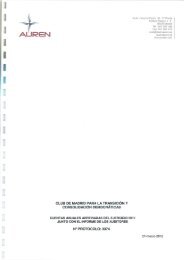Investing cultural diversity and intercultural dialogue - Business and ...
Investing cultural diversity and intercultural dialogue - Business and ...
Investing cultural diversity and intercultural dialogue - Business and ...
You also want an ePaper? Increase the reach of your titles
YUMPU automatically turns print PDFs into web optimized ePapers that Google loves.
CONCLUSION . 31<br />
Conclusion<br />
L A ‘Roi de Soleil’ mask at<br />
the Carnival in Rio de<br />
Janeiro, Brazil<br />
J One of the 6th-century<br />
Buddhas of Bamiyan, a<br />
UNESCO World Heritage site<br />
destroyed in 2001 by the<br />
then Taliban government in<br />
Afghanistan<br />
There is an urgent need to invest in <strong>cultural</strong> <strong>diversity</strong> <strong>and</strong> <strong>dialogue</strong>. Integrating <strong>cultural</strong> <strong>diversity</strong><br />
in a wide range of public policies – including those somewhat remote from the <strong>cultural</strong> field<br />
proper – can help renew the international community’s approaches to two key objectives:<br />
development <strong>and</strong> peace building <strong>and</strong> conflict prevention. Regarding development, culture is<br />
increasingly recognized as a cross-cutting dimension of the three economic, social <strong>and</strong><br />
environmental pillars of any truly sustainable development. Regarding peace <strong>and</strong> conflict<br />
prevention, acknowledging <strong>cultural</strong> <strong>diversity</strong> places the emphasis on ‘unity in <strong>diversity</strong>’, that is to<br />
say, the shared humanity inherent in our differences. Far from representing a potential restriction<br />
on universally proclaimed human rights, <strong>cultural</strong> <strong>diversity</strong> furthers their effective exercise; it<br />
strengthens social cohesion <strong>and</strong> fosters renewed forms of democratic governance. However, this<br />
requires that we refine our underst<strong>and</strong>ing of <strong>cultural</strong> <strong>diversity</strong> <strong>and</strong> <strong>dialogue</strong> so as to dispense with<br />
a number of received ideas.<br />
Towards a new underst<strong>and</strong>ing of <strong>cultural</strong> <strong>diversity</strong><br />
The World Report sets out to promote such an<br />
underst<strong>and</strong>ing by examining certain common<br />
preconceptions:<br />
● Globalization leads inevitably to <strong>cultural</strong><br />
homogenization. While globalization undoubtedly<br />
weakens <strong>cultural</strong> <strong>diversity</strong> in some respects by<br />
st<strong>and</strong>ardizing modes of life, production <strong>and</strong><br />
consumption, it equally helps to reconfigure<br />
<strong>cultural</strong> <strong>diversity</strong> in the ways highlighted in the<br />
present World Report.<br />
● Cultural <strong>diversity</strong> is reducible to the <strong>diversity</strong> of<br />
national cultures. Yet national identity is not a<br />
fixed quantity: it represents an historical<br />
construction; <strong>and</strong> identity that may appear<br />
seamless is in fact the product of multiple<br />
interactions to be found in all national contexts.<br />
● Cultural <strong>diversity</strong> <strong>and</strong> inter<strong>cultural</strong> <strong>dialogue</strong> are<br />
mutually exclusive. Rather than viewing the world<br />
as a plurality of civilizations, whether in terms of<br />
conflict (the ‘clash of civilizations’) or <strong>dialogue</strong> (the<br />
‘alliance of civilizations’), we need to move<br />
towards the reconciliation of differences whereby<br />
the harmony of the whole is born of the<br />
resonance inherent in receptiveness to others.<br />
Cultural <strong>diversity</strong> is the precondition of<br />
inter<strong>cultural</strong> <strong>dialogue</strong>, <strong>and</strong> vice versa. Without<br />
genuine <strong>dialogue</strong>, the dynamic of change (which<br />
is the very essence of <strong>cultural</strong> <strong>diversity</strong>) is not<br />
sustained, <strong>and</strong> <strong>diversity</strong> is lost or declines as a<br />
result of self-enclosure. Dialogue, including<br />
interreligious <strong>dialogue</strong> (conceived as <strong>dialogue</strong><br />
between all spiritual <strong>and</strong> intellectual traditions),<br />
does not mean that we relinquish our convictions<br />
but simply that we remain open-minded.<br />
Inter<strong>cultural</strong> <strong>dialogue</strong> must be seen as a complex<br />
<strong>and</strong> ongoing process that is never complete.<br />
● Cultural <strong>diversity</strong> <strong>and</strong> the economy are mutually<br />
incompatible. In practice, <strong>cultural</strong> <strong>diversity</strong><br />
pervades all sectors of the economy, from<br />
marketing <strong>and</strong> advertising to finance <strong>and</strong> business<br />
management. Diversity is becoming a resource,<br />
since it stimulates creativity <strong>and</strong> innov ation<br />
within the enterprise, particularly of a social kind.<br />
Recognition of the tools required for <strong>cultural</strong><br />
<strong>diversity</strong> to flourish (‘<strong>cultural</strong> intelligence’) is one<br />
of the most tangible signs of this gradual shift in<br />
the way the economic sector (<strong>and</strong> the market)<br />
views <strong>cultural</strong> <strong>diversity</strong>.<br />
● Scientific <strong>and</strong> technological progress <strong>and</strong> the<br />
<strong>diversity</strong> of <strong>cultural</strong> practices are mutually<br />
incompatible. Cultural <strong>diversity</strong> is in no way<br />
incompatible with progress or development.<br />
Indeed, the emergence of genuine ‘knowledge<br />
societies’ implies a <strong>diversity</strong> of forms of<br />
knowledge <strong>and</strong> its sources of production,<br />
including indigenous knowledge conducive<br />
to the preservation of bio<strong>diversity</strong>.<br />
Conclusion <strong>and</strong><br />
Recommendations


